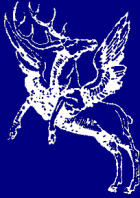Japan
Die Liste enthält 36 Einträge. Suchergebnisse löschen und Gesamtbestand anzeigen.
| Abbildung |
Beschreibung Gesamte Buchaufnahme |
Preis EUR |
|
|---|---|---|---|
 |
Kenmochi, Kazuo. Mayaku. Foto dkyumento. (Narcotics: Photographic Document). Tokyo, Inoue Shobo (1963). 4° (26,5 x 19,2 cm.). 157, (2) S. mit teils ganzs. Abb. OPbd. mit illustr. OU. in Orig.-Versandkarton.
Heiting/Kaneko 370, 280. Parr/Badger III, 82. – Erste Ausgabe der ersten Fotodokumentation zum Drogenkonsum in Japan. – 1972 und 1973 erschienen aktuallisierte Neuausgaben. – „One of the most remarkable aspects of Kazuo Kenmochi’: Narcotic Photographic Document is the date of publication 1963. The book came out at a time when the world at large was only gradually becoming aware of the problems of narcotics, and the issue was not yet the headine news that it would become only a few short years later. At that time, drugs were still something wayward that people such as jazz musicians did – that is, drug-taking was seen by the mainstream as being confined largely to the ‚other‘. Kenmochi blasts through all this and identifies drug addiction as a serious and growing problem in a classic of investigative photojournalism. The book Iooks at every aspect of drugs, from their production their distribution, the mechanics of the business and the reaction of the law. His photographs are accompanied by a comprehensive text that contains statistical diagrams and objective sociological analysis. The text is the sober part of the work, somewhat at odds with the best of Kenmochi’s photographs, which are both expressive and intimate, with something of conspiratorial air of Larry Clark“ (Parr/Badger). – Schutzumschlag am Kapital etwas berieben und mit kl. Löchlein am hinteren Gelenk, Deckelschild des Versandkartons etwas berieben, sehr gutes Exemplar. Schlagwörter: Drogen, Drugs, Japan, Photojournalism, Reportage-Photographie |
750,-- |  |
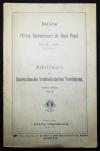 |
Vorentwurf zu einem Strafgesetzbuch für das kaiserlich japanische Reich. Übersetzt von Assatoro Okada. Berlin, J. Guttentag 1899. 8°. 53 S. OBr. (Sammlung außerdeutscher Strafgesetzbücher in deutscher Übersetzung, hrsg. von der Redaktion der Zeitschrift für die gesamte Strafrechtswissenschaft, Band 14).
Erste Ausgabe, sehr selten. – Erschien als Anhang zu den Mitteilungen der Internationalen kriminalistischen Vereinigung. 8. Band, Heft 2. Berlin, ebda. 1900. – „Das Bedürfnis nach einer Revision des geltenden japanischen Strafgesetzbuches vom 1. Januar 1882 machte sich schon bald nach seinen Inkrafttreten geltend. Als Hauptmängel ergaben sich die Enge Strafrahmen und die Unklarheit vieler Verbrechensdefinitionen, welche zu unerfreulichen Ungleichmässigkeiten und Schwankungen in der Rechtssprechung führte“ (A. Okada). – Umschlag etwas angestaubt, sehr gutes Exemplar. Schlagwörter: Japan, Strafrecht |
140,-- |  |
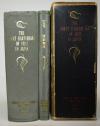 |
Fujisawa, Morihiko (Hrsg). The great earthquake of 1923 in Japan. 2 Bände. Tokyo, Bureau of Social Affairs 1926. 8°. 6 Bl., XXVI, 615 S. mit zahlr. Abb. in Schwarzweiß auf 88 Tafeln und 91 Abb. im Text in Band 1 und mit 7 Diagrammen und 11 Karten im Begleitband. OLn. mit goldgepr. Rückentitel, Rückenverg. u. rot-gold gepr. Deckelvignette sowie Kopfgoldschnitt in Orig.-Pappschuber.
Schuber etwas berieben, St. a. T., zwei Lagen von Band 1 etwas gelockert, sonst sehr gutes Exemplar. Schlagwörter: Erdbeben, Geologie, Japan |
200,-- |  |
 |
Bokujo, Koizumi (Compilation). Pictorial compendium of Japanese scenery. (Preface by F(rancis) Brinkley). Tokyo, Koizumi Bokujo 1905. Quer-4°. [2] Bl., 195 Tafeln nach Fotografien von Ogawa Kazumasa u.a., [92] Bl. Orig.-Seideneinband mit gestickter Deckelillustration, als Blockbuch gebunden.
Äußerst seltene Foto-Dokumentation, vorwiegend mit Sehenswürdigkeiten und einigen Szenen aus dem Volksleben. – Text in Japanisch und Englisch. – 1906 erschien noch „The customs of Japan (Sikishima bikan)“. – Kanten und Gelenke berieben, Deckel leicht wasserrandig, Frontispiz und Titelblatt mit Knickspuren, St.a.V., 1 Bl. mit kl. Ausriss (geringer Bildverlust), sonst gut erhalten. Schlagwörter: Japan |
650,-- |  |
 |
Hosoe, Eikoh. Barakei Sguei-sha. (Killed by roses). (Introduction by Yukio Mishima. Design by Kohei Sugiura). Tokyo, Shueisha (1963). Folio (42 x 27 cm.). [104] S. mit 43 Tafeln in Sheet-fed gravure. Illustr. OLn. mit Klarsichtschutzumschlag in illustr. Orig.-Pappkassette.
Auer 422. Heiting/Kaneko 368 f., 279. The Open Book 194 f. Parr/Badger I, 280 f. (mit mehreren Abb.). Roth, The Book of 101 Books 164 ff. – Erste Ausgabe, das wohl wichtigste japanische Fotobuch der 60er Jahre. – Von E. Hosoe und Y. Mishima im Impressum signiert. Eines von 1500 num. Exemlaren. – „Eikoh Hosoe’s first edition of Killed By Roses is so splendidly packaged that just opening it is a plearure – and the seduction doesn’t stop there. Within a black-and-white cardboard case printed an both sides with photos of carved pendants in thick chains and a fine shower of text is a glossy color cover featuring a photogram of symbolic elements plucked from Hosoe’s hallucinatory narrative, the title superimposed in classical Greek lettering. … The photos that make up the body of the book are inky, sometimes high-constrast gravures that bleed right to the edge of the page and often extend across the entire open spread, given extra impact to images that are already quite arresting. Even if the subject of Hosoe’s photographs weren’t zje author Yushi Mishima, the book would be remarkable for its humid mix of eroticism and myth, queer kitsch and high art“ (A. Roth). – „Both Japanese editions of Barakei (Killed by Roses) are significant, not only because of the remarkable collaboration between Eikoh Hosoe and Yukio Mishima, but also because they were designed by the two most influential Japanese graphic designers of the postwar years – the first edition by Kohei Sugiura and the second by Tadanori Yokoo. Each is an original working of the material in its own right, and the second, one of the most complex bookworks ever made, also memorializes a definingmoment in Japanese culture. … In his preface to the first edition, Mishima was equally disingenous: ‚One day without warning, Eikoh Hosoe appeared before me, and transported me bodily to a strange world.‘ That world, he continued, was ‚abnormal, warped, sarcastic, grotesque, savage, and promiscuous‘. Mishima allowed Hosoe unprecedented directorial freedom, but as in other such close collaborations between photographer and subject, just who had the ultimate control is open to question. What emerged was a series of extraordinary theatrical tableaux – Japanese surrealism meets Italien mannerism – that certainly contributed to the iconicity of Mishima, the samurai saviour of the country’s soul. Hosoe’s images were baroque, kitsch, frequently sadomasochistic, disturbingly narcissistic and clearly homoerotic, despite the presence of women in a number of the pictures“ (Parr/Badger). – Die Kassette teils stärker berieben, der Acetat-Schutzumschlag am Kapital etwas eingerissen, gutes Exemplar. Schlagwörter: Japan, Nummerierte Bücher, Signierte Bücher |
3.500,-- |  |
 |
Moriyama, Daido. Pantomime. Tokyo, Akio Nagasawa (2017). 4°. [18] Bl. mit 23 gefalt. Duotone Tafeln. Illustr. flex. OLn. (Silkscreen-Printed on Canvas).
Eines von 600 num. Exemplaren; auf dem Titelblatt von D. Moriyama signiert. – Mit einem Nachwort in Japanisch und Englisch (übersetzt von Andreas C. Stuhlmann). – Die Aufnahmen zeigen Foeten, aufgenommen in einem Hospital in Konagawa. – „It was a long, long time ago. Each of them was sleeping in a liquid inside a small flask about the size of a human thumb. All of them had oyster-colored skins, and were shaped like shrimps. In a glass case at the end of a row of shelves in a dark corridor of an obstetrics and gynecology hospital near the Tanzawa mountains in Kanagawa, countless fetuses in formaldehyde were quietly leaning on each other as they looked out into the sun-drenched courtyard“ (D. Moriyama). – Sehr gutes Exemplar. Schlagwörter: Japan, Nummerierte Bücher, Signierte Bücher |
320,-- |  |
 |
Nishiyama, Hideaki. The untouched light Yokohama / Yokosuka 1994-95 (Japanisch). (Book Design Kiyoshi Suzuki). Tokyo, Ryumieru (1995). Quer-Gr.-8°. 67, (5) S. mit 59 Tafeln. Illustr. OKart.
Eines von 500 Exemplaren. – „A collection of photographs by Japanese photographer Hideaki Nishiyama „The Untouched Light Yokohama · Yokosuka 1994-95“. Born in 1938 in Shanghai, he returned home with his family in the year following the end of the war, and moved to Tokushima, Osaka, and Tokyo afterward, and lived in Kamakura. As a 17-year-old high school student, he met a poem by Katsue Kitazono, and participated as a co-person in Poetry Magazine „VOU“, which he presides over. It is said that he lived in charge of poetry for almost 10 years. In 1978, she became interested in photography on the occasion of her daughter’s birth, and she started her own photography while working as an advertising agency, and held the first exhibition in mole in 1995, and was published on that occasion. Is the book. As the title, it is composed of snaps taken in Yokohama and Yokosuka, but it makes sense of the depiction of light and shadow (darkness), and it is certainly poetry. According to the person, „a photograph has a mysterious time structure that repeatedly circulates consciousness and sense from self to object, from object to self.“ Book design that brings these series of photographs into a poetic and aesthetic one. I am in charge of a representative of Japan, Kiyoshi Suzuki“ (Verlag). – Sehr gutes Exemplar. Schlagwörter: Japan, Street photography, Tokio |
140,-- |  |
 |
Araki, Nobuyoshi. Tokyo Love (Japanisch). Tokyo, Poplar Publishing (2008). 8°. [76] Bl. mit zahlr. Abb. OPbd. mit illustr. OU. u. Orig.-Bauchbinde (Obi, Bellyband).
Japanische Originalausgabe. – Von N. Araki signiert. – Die Aufnahmen zeigen Personen bei Sportveranstaltungen und anderen Freizeitbeschäftigungen in Tokio. – „Wie ein Getriebener hetzt er von Aufnahme zu Aufnahme, von Bild zu Bild. Wolkenhimmel, Blicke in die Badewanne, Katzen, Stadtansichten, immer wieder Blumen und natürlich Nackte – es scheint, als wolle der rastlose Bildersammler jeden Moment im Foto festhalten. Für Nobuyoshi Araki sind die unzähligen Aufnahmen, die er täglich macht, wie eine Art Tagebuch, das ‚die Vergangenheit ebenso beinhaltet wie die Projektion der Zukunft‘. Nicht selten belichtet er mehr als 80 Filme am Tag, denn je mehr Bilder er seiner Umgebung entreißt, desto eher erreicht seine Arbeit für ihn eine ‚kosmische Dimension‘ und wird zu einer Art ‚buddhistischem Mandala‘.“ (W. Baatz in Koetzle, Fotografie A-Z, S. 13). – Tadellos. Schlagwörter: Japan, Signierte Bücher, Sport, Street photography, Tokio |
200,-- |  |
 |
Moriyama, Daido. 4-ku. Tokyo, Waizu Shuppan (1999). Gr.-8°. [74] Bl. mit zahlr. Abb. OKart. mit illustr. OU. u. Klarsicht-Schutzumschlag. (Passage, Wides Photo Collection, Vol. I).
Von D. Moriyama signiert. – Die Aufnahmen entstanden im November 1998 und im Oktober 1999 in Nakano, Suginami, Musashino und Koganei. – D. Moriyama (geb. 1938) „zählt international zu den bekanntesten Kamerakünstlern Japans. Schilderer des gesellschaftlichen Wandels in einer an Fotografen wie Frank oder Klein geschulten radikalen Bildsprache“ (H-M. Koetzle, Fotografen A-Z, S. 282). – „Daido Moriyamas Vision liegt im Herzen der Dunkelheit, sowohl im eigentlichen als auch im übertragenen Sinne. Die Welt, die er aufzeichnet, ist schwarz, vom Licht eher betäubt als beleuchtet, bedrohlich, chaotisch, unverständlich, zwanghaft erotisch, besessen exzentrisch, konsumfixiert, verwüstet von Unfällen, nie im Gleichgewicht, manchmal zugrunde gerichtet, bisweilen leer – eine Welt, die sich ihrer eigenen Instabilität nicht bewusst ist, eine Welt, die Prozac braucht. Seine fotografischen Methoden, geprägt von Unschärfen und Kratzern, ausgeblichenen Farben und Staub, verschmelzen mit seinen Motiven zu Dolkumenten, die kurz vor dem Verfall stehen. Manchmal spielt Moriyama mit den Grenzen der Wahrnehmung und mit den Grenzen der Fotografie; beides lässt er hoffnungslos eng gesteckt erscheinen. Eine unerbittliche, sogar grimmige Vision, individuell und authentisch, die bis an ihre eigenen Grenzen geht“ (V. Goldberg in Koetzle, Fotografen A-Z). – Tadellos. Schlagwörter: Japan, Street photography |
320,-- |  |
 |
Hosoe, Eikoh. Kamaitachi. (Dance Tatsumi Hijikata. Preface Shuzo Takigushi. Poem Toyoichiro Miyoshi. Design Ikko Tanaka). Tokyo, Gendai Shicho Sha (1969). Folio (38 x 31 cm.). [3] Bl., 34 Tafeln, [2] Bl., alle ausfaltbar u. 1 Orig.-Photographie (Silbergelatine, 24,5 x 16 cm.) auf dem Trägerkarton und verso signiert und mit Stempel des Fotografen, dat. 1971. Illustr. OLn. mit Blau bedrucktem Klarsichtschutzumschlag in Orig.-Pappschuber u. Orig.-Versandkarton mit Deckelschild.
Auer 497. Heiting/Kaneko 394 f., 306. Parr/Badger I, 284. The Open Book 248. – Erste Ausgabe. – Eines von 1000 num. Exemplaren. – Von E. Hosoe signiert und mit rotem Signaturstempel T. Miyoshi und mit beil. Orig.-signiertem Silbergelatine Abzug. Plate # 32 (1965, „drei Generationen“). – „Many Japanese photobooks are designed around the ritual of removing them from their slipcases or covers and opening their pages. The second book collaboration between Hosoe and the dancer Tatsumi Hijikata makes a complex ceremony even of viewing each photograph. Every picture page is a blue gatefold that must be carefully unfolded before the image can be viewed. Looking at this book cannot be done in a hurry. Kameitachi derives from a journey that Hosoe made to the far north of Japan’s main island after returning home from a European trip in 1964. He travelled with Hijikata to the Tohoku region. Both had been born there“ (Parr/Badger). – “Hijikata was dissatisfied with the Japanese modern dance scene, feeling that it was merely a copy of the work being done in the West. He wanted to find a form of expression that was purely Japanese, and one that allowed the body to ‘speak’ for itself, thru [sic!] unconscious improvised movement. His first experiments were called Ankoku Butoh, or the Dance of Darkness. This darkness referred to the area of what was unknown to man, either within himself or in his surroundings. His butoh sought to tap the long-dormant genetic forces that lay hidden in the shrinking consciousness of modern man” (Eikoh Hosoe). – Versandkarton mit geringf. Gebrauchsspuren, 2 Tafeln im rechten Rand mit leichten Knickspuren, sonst tadellos. Schlagwörter: Japan, Nummerierte Bücher, Original-Photographie, Signierte Bücher, Tanz |
9.500,-- |  |
 |
Shinoyama, Kishin. Silk Road. (Interview by Patrick Remy). Paris, Louis Vuitton Malletier (2018). 4°. [304] S. mit meist doppelblattgr. Farbtafeln. OLn. mit farb. Deckelbildern. (Louis Vuitton Fashion Eye).
Teilausgabe der von Mai 1981 bis Juli 1982 bei Shueisha in Tokio erschienenen Reihe. Die 14 Bände präsentierten über 1200 Aufnahmen aus Japan, Korea, China und dem Vorderen Orient. – Von K. Shinoyama auf dem Titelblatt signiert. – Text in Englisch und Französisch. – „Sélection parmi huit albums publiés par le photographe japonais en 1981 et 1982 de photographies de sites et de monuments prises en Asie et Asie centrale. … Louis Vuitton Fashion Eye est une collection d’albums photographiques qui donne à voir une destination à travers l’il d’un photographe de mode. Elle instaure un dialogue inédit entre des talents émergents, des photographes chevronnés et des légendes de la photographie de mode; Fashion Eye met en regard la création actuelle et des trésors darchives méconnus pour constituer une collection douvrages de référence, tant dans son approche que dans son esthétique“ (Louis Vuitton Malletier). – Tadellos. Schlagwörter: Asia, Central, Asien, China, Japan, Landscape photography, Landschaftsfotografie, Seidenstrasse, Signierte Bücher, Silk Road |
200,-- |  |
 |
Ogawa Kazumasa – Takashima, S(uteta). The Hanami (Flower-Picnic). (Published by Kazumasa Ogawa). Yokohama, Hongkong, Shanghai, Singapore, Kelly and Walsh 1897. Quer-Folio (29 x 38 cm.). [2] Bl., 25 farb. Lichtdruck-Tafen (Collotypes), davon 24 nach Photographien von K. Ogawa. OPbd. mit floralem Krepppapierbezug u. Deckelschild, als Blockbuch gebunden.
Einzige Ausgabe. – Seltenes aufwendig ausgestattetes Album mit sparsam kolorierten Aufnahmen, welche bei den tradionellen Kirschblüten-Festen (Hanami) in Ueno Park, Mukojima und Koganei entstanden. – „By the end of the 19th century the first photographic publications about Japan by a Japanese photographer were published in Boston and London, though Japan showed little interest in them. Many of the early photographs in these „foreign“ publications came from the studio of Ogawa Kazumasa who was also a printer and publisher. He had learned English and the craft of photomechanical printing in Boston. Returning to Japan in 1884, he opened his first studio in Tokyo the next year. At the time, it seems that there were few, if any, Japanese photo publications and most were made for Western consumption. Culturally, Japan was still burdened by its feudal history, which made it suspicious of anything new or Western“ (M. Heiting in Heiting/Ryuichi S. 9). – Rücken am Fuß mit kl. Fehlstelle am Bezugspapier, gutes sauberes Exemplar. Schlagwörter: Japan |
1.200,-- |  |
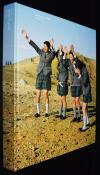 |
Pol, Andri. Where is Japan. Göttingen, Steidl 2010. 4°. 315 S. mit zahlr. farb. Abb. Farbig illustr. OPbd.
Erste Ausgabe. – Sehr gutes und sauberes Exemplar. Schlagwörter: Japan |
40,-- |  |
 |
(Hoshino, Tatsuo, Ed.). Changing Japan. Seen through the camera. Image du Japon. (Preface par Georges Asot). Tokyo, Asahi Shimbun Publishing Co. (1933). Gr.-8°. [2] Bl., 292 S. mit zahlr. Abb. auf 291 Tafeln. OLn.
Erste Ausgabe. – Text Englisch und Französisch. – Kapital etwas bestoßen, gutes Exemplar. Schlagwörter: Japan |
100,-- |  |
 |
Takagi, T(ejiro, Ed.). Girls’ pastimes in Japan. Kobe, The Tamamura Photographic Studio & Art Gallery (um 1910). Quer-8°. Illustr. farblithogr. Titel u. 24 handkol. Lichtdruck-Tafeln mit gedr. Bildunterschriften in Englisch, [1] Bl. (Impressum). Illustr. Orig.-Seideneinband mit Kordelbeftung (als Blockbuch gebunden).
Vgl. Bennett, Old Japanese Photographs S. 292. – Erste Ausgabe. – Japanische Mädchen bei verschiedenen Freizeitbeschäftigungen, u. a. Teezeremonie, Blindekuh-Spielen, Hausmusik, Gartenspaziergang etc. – T. Takagi, zunächst ab 1903 Manager der Zweigniederlassung von Tamamura und ab 1904 Eigentümer der Firma, führte das Geschäft bis 1914 unter dem Namen von Tamamura. – Der japanische Fotopionier Tamamura Kozaburo (1856-1923 ?) gründete bereits 1874 in Asakusa bei Tokio sein Fotoatelier, nach dem Umzug nach Yokohama 1883 entwickelte sich das Studio zum erfolgreichsten Fotoatelier in Japan. Tamamura produzierte vor allem Souvenier-Alben und Ansichten für Touristen. Daneben arbeitete er als Porträt-Fotograf. – Ecken berieben, blattränder teils etwas fingerfleckig, sonst gut erhalten. Schlagwörter: Japan |
320,-- |  |
 |
Fieger, Erwin. Japan. Sunrise-Islands. (Vorwort von L. Fritz Gruber). Düsseldorf, Accidentia Druck- und Verlags-GmbH 1971. Quer-Folio (32 x 45 cm.). [22] Bl. u. 160 Farbtafeln. OHln. in Korkoptik mit japanischer Kalligraphie u. farbig illustr. Orig.-Buchkassette.
Heidtmann 15078. – Texte in Deutsch, Englisch und Französisch von Adolf Muschg und Nicolas Bouvier. – Erwin Fieger (1928-2013) „zählt zu den Pionieren einer neuen Farbästhetik in der Colorfotografie der bundesrepublikanischen Nachkriegszeit. Seine Ausstellungen auf der Photokina in Köln und zahlreiche Bildbände im Genre der Reisefotografie bahnen der Farbfotografie den Weg bis zu ihrer Etablierung als autonomes künstlerisches Medium“ (Deutsche Fotothek). – Sehr gutes Exemplar. Schlagwörter: Japan |
50,-- |  |
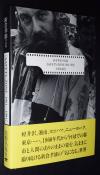 |
Niikura, Takao. Safety-Zone 1961-1991. (Foreword: Kiyoji Otsuji). Tokyo, Bijutsu Shuppansha (1991). Gr.-8°. 225, (1) S. mit 100 Tafeln. OPbd. mit illustr. OU. u. Orig.-Bauchbinde (″Obi“).
Umfassende Werkschau des japanischen Fotografen T. Niikura. – Texte in englisch und japanisch. – Inhalt: At Karuizawa, Shonan – Seaside Memory, Yokohama Peaople, Boxing gym, New York 1973, Showa safety era. – Buchgestaltung: Toshiro Habara. – T. Niijura studierte Anfang der 1960er Jahre bei Kiyoji Otsuji (1923-2001) und gehörte in den 1970er Jahren zusammen mit Gocho Shigeo und Masao Sekiguchi zu der Gruppe „Compola Photography“, die in Japan für Aufsehen sorgte. – Sehr schönes Exemplar. Schlagwörter: Japan |
100,-- |  |
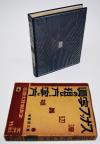 |
Watanabe Yoshio. Sunappu shashin no neraikata utsushikata. (So macht man Schnappschüsse, How to compose and shoot snapshots). Tokyo, Genkô-sha 1937. 8°. 276 S. mit zahlr. Abb. OLn. mit ornamentaler Silberprägung in Orig.-Pappschuber. (Shashin jitsugi daikoza 4, Practical Photography, Series 4).
Heiting/Kaneko 124, 60. – Erste Ausgabe. – Buch-Gestaltung von Kôshirô Onchi. – Der bedeutende japanische Fotograf Watanabe Yoshio (1907-2000) arbeitete schon früh mit kleinformatigen Kameras wie der Leica. „1928 machte er seinen Abschluss an dem „Tokyo Photography Institute“, der Nachfolgereinrichtung der „Konishi Photography School“, und nahm seine Arbeit bei der „Oriental Photos Industry Company“ auf. Er gewann einen Sonderpreis in einem Wettbewerb, der von dem Magazin „Asahi Graph“ ausgerichtet worden war. Er wechselte zur Anzeigenabteilung des Unternehmens und wurde zuständig für die fotografischen und textlichen Beiträge für die monatlichen Magazine „Oriental News“ und „Photo Times“. 1934 verließ Watanabe das Unternehmen und eröffnete im folgenden Jahr das „Watanabe Studio“. Wandfotos von ihm waren im japanischen Pavillon auf der Weltfachausstellung Paris 1937 zu sehen. Im selben Jahr besuchte er in Auftrag der Abteilung für Nachrichtendienste des Außenministeriums Nanking und Shanghai. Nach dem Zweiten Weltkrieg begann Watanabe 1950 an der Nihon-Universität zu unterrichten. …1957 gewann er den Jahrespreis der „Photographic Society of Japan“ (Nihon shashin kyokai) und 1958 den Preis des Kultusministers (Mombudajin sho). 1958 wurde er Vorsitzender der „Japan Professional Photographers’ Society“ (Nihon shashinka kyokai). 1965 wurde er Vorsitzender der „All-Japan Photographers’ and Writers’ Association“ (Zen Nihon shashinka sakka domei) und 1971 Vorsitzender der „All-Japan Photographers’ and Writers’ Copyright Association“ (Zen Nihon shashinka chosakuken kyokai), stellvertretender Vorsitzender der „Photographic Society“. … Watanabe war der erste Fotograf, der Anstrengungen unternahm, eine Fotogalerie zu betreiben. Er war auch der erste japanische Fotograf, der vom Staat als „Person mit besonderen kulturellen Verdiensten“ (1990) ausgezeichnet wurde“ (Wikipedia). – Schuber etwas berieben u. gebräunt, sehr gutes Exemplar. Schlagwörter: Japan |
600,-- |  |
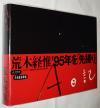 |
Araki, Nobuyoshi. A Nikki. (Ein Tagebuch, A diary). Tokyo, Lithofort 1995. Quer-8°. [104] Bl. mit farb. Abb., [4] Bl. (Text). OLn. mit farbig illustr. OU. u. Orig.-Bauchbinde (″Obi“).
Erste Ausgabe. – „Nobuyoshi Araki – the best known and most controversal Japanese photographer, who produced around three hundred books is a unique phenomenon in nude photography. … His insistence on photographing the public area was in defiance of censorship; on several occasions his exhibitions were shut down by the police, who confiscated his works and arrested Araki and his assistants on the spot“ (A. Bertolotti zu Otoko to onna no aida niwa kamera ga aru, Tokio 1978). – Tadellos. Schlagwörter: Aktfotografie, Aktphotographie, Japan, Photography of the nude |
200,-- |  |
 |
Fukuda Katsuji. Sakuga no jissai. Watasi no shashinshû. (Handbuch der Photographie – Mein Photo-Album 1939). Tokyo, Ars 1938. Gr.-8°. 146 S., [9] Bl. mit 58 Abb. OLn. mit silbergepr. Rücken- u. Deckeltitel, illustr. Orig.-Schutzumschlag in Orig.-Pappschuber.
Heiting/Kaneko 126, 62. – Erste Ausgabe, selten. – Fukuda Katsuji (1899-1991) arbeitete seit 1920 für Takachiho Seisakujo (heute Olympus) in Tokio, nach 1923 betrieb er Fotoateliers in Sakai und Osaka. Anschließend arbeitete er als Fotojounalist. 1933 nach Tokio zurück gekehrt widmete er sich, beeinflusst von den modernistischen Strömungen aus Europa (besonders durch Moholy-Nagy), der Werbefotografie. Seine Arbeiten wurden besonders durch das vorliegende Werk bekannt. Nach dem Krieg veröffentlichte er besonders Aktstudien und Bücher zur Fototechnik. Eine große Werkschau seiner Arbeiten wurde 1994 im Yamaguchi Prefectural Museum of Art präsentiert. – „There are no photographers of women in Japan even today who have not been influenced by Fukuda in one way or another. Many techniques commonly used today were developed by Fukuda, a fact which has been forgotten“ (Akira Hasegawa). – Schuber etwas berieben, fleckig und angestaubt, Schutzumschlag am Vorderdeckel mit kl. Randläsur, sehr gutes Exemplar. Schlagwörter: Japan |
650,-- |  |
 |
Tokiwa Toyoko. Kiken na adabana. (Giftige Blumen). Tokyo, Mikasa-shobô (1957). 8°. 248 S. mit Abb. auf Tafeln. OPbd. mit goldgepr. Rückentitel, illustr. Orig.-Schutzumschlag, Bauchbinde (″Obi“, belly band) u. Cellophan-Schutzumschlag.
The History of Japanese Photography S. 217 u. 236 f. Lederman/Yatskevich, What they saw 144 f. – Erster Druck der ersten Ausgabe. – Wichtigste Veröffentlichung der bedeutenden japanischen Fotografin Tokiwa Toyoko (1928-2019). – Die Aufnahmen zeigen Straßenszenen, Prostituierte und amerikanische Marine-Soldaten im Rotlichtviertel von Yokohama. Der seltene Schutzumschlag zeigt auf der Vorderseite das Gesicht der Fotografin mit ihrer Canon-Kamera; im Objektiv ist ein Detail aus dem letzten Foto zu sehen. Der rote „Obi“ wirbt für 100 Fotografien. – T. Tokiwa „documents a vibrant community of women operating on the fringes of postwar Japanese society. The title references a traditional euphemism for sex workers, who held a partivular form of cultural cachet in Tokiwa’s hometown, the port city of Yokohama. While prostitution is a major subject in Kiken na adabana, the photobook more brodly cronicles the daily lives of working women – including nurses, shop clerks, teachers and performers – and as a result, demystifies sex work for what it really is: a job. … As one of the only female photographers active in Yokohama during this time, Tokiiwa uniquely experienced the challenges of working within a patriarchal environment. Despite her proffessional status as an observer, the photographer herself became an object of fascination and increased scrutiny amoung her peers. Tokiwa toys with this irony throuout Kiken na adabana – perhaps most significantly in the book cover, a self-portrait of the artist holding a camera. A smaller photgraph of a woman being forciby dragged by her male companion is superimposed in place of the Photographer’s lens. This image spotlights Tokiwa’s role as both a witness and active participant in the social upheaval of mid-century Japanese society“ (Rose Bishop in Lederman/Yatskevich). – „(This book) can be considered the strongest, most compassionate work by a female photographer of that era“ (Anne Tucker). – Schutzumschlag am Kapital mit kleiner Fehlstelle, Textbl. papierbedingt etwas gebräunt, sehr gutes Exemplar. Schlagwörter: Japan |
1.400,-- |  |
 |
Klein, William. Tokio. Vorwort von Richard Friedenthal. Hamburg, Nannen 1965. 4°. 184 S. mit 169 Tafeln. OLn. mit farbig illustr. OU. (″Die Zeit“ Bücher).
Heidtmann 18455. Vgl. Auer 437. Koetzle 232 f. The Open Book 206 f. Roth, The Book of 801 Books 140 ff. (Alle amerik. Originalausgabe von 1964). – Erste deutsche Ausgabe. – Mit eigenhändiger Widmung von W. Klein „to Stefan Thull, hopefull (2 japanische Schriftzeichen) William Klein“. – Der bedeutende amerikanische Fotograf, Maler, Grafiker und Filmemacher W. Klein (geb. 1928) ist „als Kamerakünstler eine der einflussreichsten Persönlichkeiten im Europa der 50er und frühen 60er Jahre“ (Koetzle). – S. Thull (geb. 1958 in Aachen) „Kravattenexperte“, Werbeberater, Verfasser von Mode-Publikationen und Kunstsammler lebt und arbeitet seit 2021 in Pforzheim. Thull ist seit 1998 auch Mitglied der DGPh (Deutsche Gesellschaft für Photographie), wo er bis heute zahlreiche Fotobücher vorgestellt hat. – Schutzumschlag am Kapital geringf. berieben, sehr gutes Exemplar. Schlagwörter: Japan, Signierte Bücher, Widmungsexemplar |
1.200,-- |  |
 |
Hosoe, Eikoh. Barakei Sguei-sha. (Killed by roses). (Introduction by Yukio Mishima. Design by Kohei Sugiura). Tokyo, Shueisha (1963). Folio (42 x 27 cm.). [104] S. mit 43 Tafeln in Sheet-fed gravure, 2 gefalt. Beilagen u. Orig.-Rechnung für einen dänischen Kunden des Verlags vom 18. August 1964. Illustr. OLn. mit Orig.-Baubinde (″Obi“) u. Klarsichtschutzumschlag in illustr. Orig.-Pappkassette.
Auer 422. Heiting/Kaneko 368 f., 279. The Open Book 194 f. Parr/Badger I, 280 f. (mit mehreren Abb.). Roth, The Book of 101 Books 164 ff. – Erste Ausgabe, das wohl wichtigste japanische Fotobuch der 60er Jahre. – Von E. Hosoe und Y. Mishima im Impressum signiert. Eines von 1500 num. Exemlaren. – „Eikoh Hosoe’s first edition of Killed By Roses is so splendidly packaged that just opening it is a plearure – and the seduction doesn’t stop there. Within a black-and-white cardboard case printed an both sides with photos of carved pendants in thick chains and a fine shower of text is a glossy color cover featuring a photogram of symbolic elements plucked from Hosoe’s hallucinatory narrative, the title superimposed in classical Greek lettering. … The photos that make up the body of the book are inky, sometimes high-constrast gravures that bleed right to the edge of the page and often extend across the entire open spread, given extra impact to images that are already quite arresting. Even if the subject of Hosoe’s photographs weren’t zje author Yushi Mishima, the book would be remarkable for its humid mix of eroticism and myth, queer kitsch and high art“ (A. Roth). – „Both Japanese editions of Barakei (Killed by Roses) are significant, not only because of the remarkable collaboration between Eikoh Hosoe and Yukio Mishima, but also because they were designed by the two most influential Japanese graphic designers of the postwar years – the first edition by Kohei Sugiura and the second by Tadanori Yokoo. Each is an original working of the material in its own right, and the second, one of the most complex bookworks ever made, also memorializes a definingmoment in Japanese culture. … In his preface to the first edition, Mishima was equally disingenous: ‚One day without warning, Eikoh Hosoe appeared before me, and transported me bodily to a strange world.‘ That world, he continued, was ‚abnormal, warped, sarcastic, grotesque, savage, and promiscuous‘. Mishima allowed Hosoe unprecedented directorial freedom, but as in other such close collaborations between photographer and subject, just who had the ultimate control is open to question. What emerged was a series of extraordinary theatrical tableaux – Japanese surrealism meets Italien mannerism – that certainly contributed to the iconicity of Mishima, the samurai saviour of the country’s soul. Hosoe’s images were baroque, kitsch, frequently sadomasochistic, disturbingly narcissistic and clearly homoerotic, despite the presence of women in a number of the pictures“ (Parr/Badger). – Die Kassette etwas berieben, der Acetat-Schutzumschlag um unteren Rand mit kl. Läsuren, vord. Innengelenk minimal angeplatzt, sehr gutes Exemplar mit der fast immer fehlenden Orig.-Bauchbinde. Schlagwörter: Japan, Nummerierte Bücher, Signierte Bücher |
4.800,-- |  |
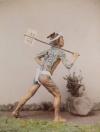 |
Ogawa Kazumasa – Brinkley, F(rancis, ed.). Japan, described and illustrated by the Japanese. Written by eminent Japanese authorities and scholars. 10 Bände. Boston, Mass, J. B. Millet (1897-1898). Folio (41 x 32 cm.). Mit 15 farb. Tafeln (Orchideen und andere Blumen, Collotypes), 30 handkol. Orig.-Photographien (Albuminabzüge, jeweils ca. 25 x 19 cm.), 220 Abb. im Text u. 15 farblithogr. Ornament-Tafeln auf Tonpapier. OHln. mit goldgepr. illustr. Deckelsch. (als Blockbuch gebunden).
Heiting/Ryuichi S. 10 f. (Emperer’s edition). – „Tokyo edition. Limited to five hundred copies, of which this is copy No. 211“. – Die früheste und umfangreichste Buchreihe über Japan mit Orig.-Photographien. – Insgesamt erschienen 7 teils num. Ausgaben. – Die meisten Aufnahmen stammen von dem japanischen Fotopionier Ogawa Kazumasa (auch Ogawa Kazuma oder Ogawa Isshin, 1860-1929), darunter auch die schönen Farbtafeln verschiedener Blumen (die heute noch als Kunstdrucke angeboten werden, vorliegende num. Ausgabe mit 5 zusätzlichen Tafeln), die berühmte Aufnahme des Fuji (″Mount Fuji as seen from Kashiwabara“), japanische Ringer, Frauen bei einer Tee-Zeremonie, „Tatooed Postman“ u. a. – Ogawa studierte bereits als 15jähriger bei Yoshiwara Hideo Englisch und ging 1880 nach Tokio um seine Englischkenntnisse zu verbessern. In Yokohama wurde er von Shimooka Renjo, einem der ersten professionellen Fotografen, ausgebildet. 1882 ging er nach Boston, wo er Kurse in Portraitfotografie belegte und bei der Albert Type Company den Lichtdruck kennenlernte. Nach seiner Rückkehr nach Japan 1884 eröffnete er in Iidabashi (Kojimachi) ein Fotoatelier, das erste in Tokio. Vier Jahre später gründete er eine Fabrik für Trockenplatten und 1889 Japans erste Druckerei für Lichtdrucke (Ogawa Shashin jo). Ogawa war auch Redakteur bei zwei frühen japanischen Fotozeitschriften, die in seinem Unternehmen im Lichtdruck-Verfahren hergestellt wurden. Außerdem war er Gründungsmitglied der Japan Photographic Society. – „By the end of the 19th century the first photographic publications about Japan by a Japanese photographer were published in Boston and London, though Japan showed little interest in them. Many of the early photographs in these „foreign“ publications came from the studio of Ogawa Kazumasa who was also a printer and publisher. He had learned English and the craft of photomechanical printing in Boston. Returning to Japan in 1884, he opened his first studio in Tokyo the next year. At the time, it seems that there were few, if any, Japanese photo publications and most were made for Western consumption. Culturally, Japan was still burdened by its feudal history, which made it suspicious of anything new or Western“ (M. Heiting). – 3 Bände mit Abriebstellen am Bezugspapier, Ecken etwas bestoßen, sonst sehr gut erhalten. Schlagwörter: Description and travel, Japan, Nummerierte Bücher, Original-Photographie |
3.500,-- |  |
 |
Moriyama, Daido – Takuma, Nakahira. Shashin yo sayonara (Farewell, Photography, Bye Bye Photography). Tokyo, Shashin Hyoronsha (1972). Gr.-8°. [308] S. mit teils doppelblattgr. Tafeln in shed-fed-gravure. OKart. mit OU.
Auer 543. Heiting/Kaneko 344 f., 256. Parr/Badger I, 298 u. II, 206 u. 318. The Open Book 290 f. Roth, The Book of 101 Books 218 ff. – Erste und einzige Ausgabe, eines der wichtigsten japanischen Fotobücher und des bekanntesten Werks des berühmten japanischen Fotografen. – Dazu: Orig.-Photographie (Silbergelatine, 23 x 15,5 cm.), Rückenakt. verso von D. Moriyama signiert und num. 125/150. – „Chaotic everyday existance is what I think Japan is all about. This kind of theatricality is not just a metaphor but is also, I think, our actual reality“ (D. Moriyama). – „To get even closer to this actual reality, to record it more thruthfully, Moriyama wanted to make himself a machine, to get beyond subjectivity and become more like a camera, and this desire is brought to a new level in ‚Bye, Bye Photography, Dear‘.“ (D. Levi Strauss in Roth). – „Shashin yo sayonara ( Bye Bye Photography) is the most extreme monument of the Provoke period, indeed one of the most extreme photobooks ever published … Moiyama’s vision is entirely consistent, and his willingness to be led to the edge of photography’s coherence is the photographic equivalent of Surrealist automatic writing by a camera that almost has a mind of its own. „I wanted to go to the end of photography“ he declared, and the book is a summation of the Provoke period. It reads like a jerkly hand-held cinéma vérité film“ (Parr/Badger). – Sehr gutes Exemplar. Schlagwörter: Japan, Original-Photographie, Signierte Bücher |
6.500,-- |  |
 |
Benl, Oscar (Hrsg.). Liebesgeschichten des japanischen Kavaliers Narihira aus dem Ise-monogatari. Aus dem Ise-Monogatari. München, Hanser 1957. 8°. 47 S. mit 14 farbigen Wiedergaben nach den Sotatsu zugeschriebenen Bildern. Handgebundener blauer Orig.-Seideneinband in mit hellgrauer Seide bezogenem Pappumschlag.
Eines von 500 Exemplaren auf Japanbüttenpapier. – Handgebunden von Sonnfriede Scholl. – Private Widmung auf Vorsatz, Schließen fehlen, sonst sehr gutes und sauberes Exemplar Schlagwörter: Einbände, Handeinband, Japan, Nummerierte Bücher, Vorzugsausgaben |
40,-- |  |
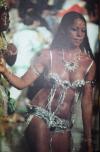 |
Shinoyama, Kishin. Olele Olala. Presented by Kishin Shinoyama. (Tokyo), Shueisha (1971). 4°. [280] S. mit ca. 250 meist farb. Abb. Farbig illustr. OKart.
Parr/Badger III, 37. Nicht bei Heiting/Ryuichi. – Einzige Ausgabe, selten. – Text in japanisch und englisch. – „Kishin Shinoyama & his mad crew, challenged Brazil, the land of dazzling sex-craze at the other end of the globe!! Here!! the human document of his bitter-comic struggle for 25 days !“ – „If sex sells, then sun, sand and Brazilian beauties in conjunction with sex sells even more. Several Pirelli calendars have been shot in Rio de Janeiro, and it seems a natural destination when product – Hitachi electric shavers – is being marked as ‚sexy‘, and the shooting budget allows it. Kishin Shinoyama is one of Japan’s best-known commercial photographers, probably the country’s most successful commercial photographer, renowned for his celebrity potraits and his female nudes, where he rivals even Nobuyoshi Araki. … His nude work can tend towards the arty-prtentious – shades of Bill Brandt – but in this vibrant company book, where it is doing a straightforward selling job, it shines in its natural setting. Like Immagini per una Industria, this is a fun book, but the photography is rather better than in the Italian volume, anticipating Bruce Weber, David Alan Harvey and other photographers of the Copacabana scene and the Rio Carnival“ (Parr/Badger). – Von leichten Gebrauchs- und Altersspuren abgesehen, gut erhalten. Schlagwörter: Brasilien, Brazil, Carnival, Japan, Photography of the nude, Promotion, Rio de Janeiro, Street photography, Werbung |
400,-- |  |
 |
Ogawa Kazumasa – Takahashi, K. (Übers.). Japanaj vidajoj kaj moroj (Esperanto, Japanische Ansichten und Bräuche). Tokio, Kjobasi-ku 1914. Quer-8° (19 x 25,5 cm.). [2] Bl., 50 Tafeln von K(azumasa) Ogawa, [4] Bl. Farbig illustr. OKart. (als Blockbuch gebunden).
Zuerst 1910 erschienenes Album für Japan-Besucher mit Aufnahmen des wichtigsten japanischen Fotografen des ausgehenden 19. und beginnenden 20. Jahrhunderts. – Text in japanisch und esperanto. – Der japanische Foto-Pionier Ogawa Kazumasa (auch Ogawa Kazuma oder Ogawa Isshin, 1860-1929) studierte bereits als 15jähriger bei Yoshiwara Hideo Englisch und ging 1880 nach Tokio um seine Englischkenntnisse zu verbessern. In Yokohama wurde er von Shimooka Renjo, einem der ersten professionellen Fotografen, ausgebildet. 1882 ging er nach Boston, wo er Kurse in Portraitfotografie belegte und bei der Albert Type Company den Lichtdruck kennenlernte. Nach seiner Rückkehr nach Japan 1884 eröffnete er in Iidabashi (Kojimachi) ein Fotoatelier, das erste in Tokio. Vier Jahre später gründete er eine Fabrik für Trockenplatten und 1889 Japans erste Druckerei für Lichtdrucke (Ogawa Shashin jo). Ogawa war auch Redakteur bei zwei frühen japanischen Fotozeitschriften, die in seinem Unternehmen im Lichtdruck-Verfahren hergestellt wurden. Außerdem war er Gründungsmitglied der Japan Photographic Society. – „By the end of the 19th century the first photographic publications about Japan by a Japanese photographer were published in Boston and London, though Japan showed little interest in them. Many of the early photographs in these „foreign“ publications came from the studio of Ogawa Kazumasa who was also a printer and publisher. He had learned English and the craft of photomechanical printing in Boston. Returning to Japan in 1884, he opened his first studio in Tokyo the next year. At the time, it seems that there were few, if any, Japanese photo publications and most were made for Western consumption. Culturally, Japan was still burdened by its feudal history, which made it suspicious of anything new or Western“ (M. Heiting in Heiting/Ryuichi S. 9). – Sehr gutes Exemplar. Schlagwörter: Japan |
650,-- |  |
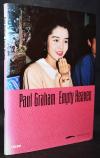 |
Graham, Paul. Empty heaven. Photographs from Japan 1989 – 1995. Fotografien aus Japan 1989 – 1995. (Katalogbuch zur Ausstellung im Kunstmuseum Wolfsburg, 19 Aug. bis 12 Nov. 1995). Zürich, Berlin, New York, Scalo (1995). 4°. [88] S. mit 55 Farbtafeln u. Textheft (dt.-engl., 6 Bl.). OPbd. mit farbig illustr. OU.
Einzige Ausgabe. – „Paul Grahams Motive haben wenig gemeinsam mit der klischeehaften Vorstellung vom Leben in Japan. Die meisten Bilder sind Nahaufnahmen, sie sind nicht mit dem Weitwinkelobjektiv des klassischen Fotojournalismus, aber alle mit direktem Blitz fotografiert. Ihnen wohnt eine extreme Klaustrophobie inne, eine unausweichliche Konfrontation mit dem Traumatischen und mit dem Trivialen“ (Kunstmuseum Wolfsburg). – Schutzumschlag am Rücken u. Rückendeckel etwas aufgehellt, sehr gutes Exemplar. Schlagwörter: Japan |
140,-- |  |
 |
Klein, William. Tokio. Vorwort von Richard Friedenthal. Hamburg, Nannen 1965. 4°. 184 S. mit 169 Tafeln. OLn. mit farbig illustr. OU. (″Die Zeit“ Bücher).
Heidtmann 18455. Vgl. Auer 437. Koetzle 232 f. The Open Book 206 f. Roth, The Book of 801 Books 140 ff. (Alle amerik. Originalausgabe von 1964). – Erste deutsche Ausgabe. – Der bedeutende amerikanische Fotograf, Maler, Grafiker und Filmemacher W. Klein (1928-2022) ist „als Kamerakünstler eine der einflussreichsten Persönlichkeiten im Europa der 50er und frühen 60er Jahre“ (Koetzle). – Schutzumschlag am Rückendeckel mit hinterlegtem Randeinriss, gutes Exemplar. Schlagwörter: Japan |
320,-- |  |
 |
Hosoe, Eikoh. Kamaitachi. (Dance Tatsumi Hijikata. Preface Shuzo Takigushi. Poem Toyoichiro Miyoshi. Design Ikko Tanaka). Tokyo, Gendai Shicho Sha (1969). Folio (38 x 31 cm.). [3] Bl., 34 Tafeln, [2] Bl., alle ausfaltbar. Illustr. OLn. mit Blau bedrucktem Klarsichtschutzumschlag in Orig.-Pappschuber.
Auer 497. Heiting/Kaneko 394 f., 306. Parr/Badger I, 284. The Open Book 248. – Erste Ausgabe. – Eines von 1000 num. Exemplaren. – Von E. Hosoe signiert und mit rotem Signaturstempel T. Miyoshi. – „Many Japanese photobooks are designed around the ritual of removing them from their slipcases or covers and opening their pages. The second book collaboration between Hosoe and the dancer Tatsumi Hijikata makes a complex ceremony even of viewing each photograph. Every picture page is a blue gatefold that must be carefully unfolded before the image can be viewed. Looking at this book cannot be done in a hurry. Kameitachi derives from a journey that Hosoe made to the far north of Japan’s main island after returning home from a European trip in 1964. He travelled with Hijikata to the Tohoku region. Both had been born there“ (Parr/Badger). – Der Klarsicht-Schutzumschlag am Rückendeckel im unteren Drittel etwas beschädigt (jedoch komplett), sonst tadellos. Schlagwörter: Japan, Nummerierte Bücher, Tanz |
4.800,-- |  |
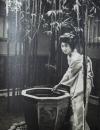 |
(Shimbun, Asahi, Ed.). Changing Japan. Seen through the camera. Image du Japon. First Printing. Tokyo, Asahi Shimbun 1933. 4°. 292 S. mit überw. Abb. OLn.
Text in englisch und französisch. – Einband etwas berieben, sonst sehr gut erhalten. Schlagwörter: Japan |
70,-- |  |
 |
Kon – Murakami, Ryu u. Toshiharu Ito. Michiko Kon. Art direktion: Toshio Yamagata. (Tokyo), Korinsha Press (1997). Gr.-4° (35 x 28 cm.). [6] Bl., 50 (4 farb.) Tafeln, [8] Bl. Weinroter OLn. in silberfarb. Orig.-Pappkassette mit Deckelbild.
Erste Ausgabe. – Die japanische Fotografin Michiko Kon (geb. 1955 in Kanagawa) machte 1978 ihren Abschluss an der Sokei Art School. Danach besuchte sie bis 1980 das Tokyo Photographic College, nachdem sie während ihrer Jahre in Sokei hauptsächlich Malerei und Druckgrafik studiert hatte. Die meisten ihrer Fotografien sind Schwarz-Weiß-Abzüge mit minimalistischem Hintergrund und behandeln oft Themen wie Tod, Sexualität und Schönheit. Sie verwendet einzigartige Multimedia-Inhalte und ist vor allem dafür bekannt, dass sie Meeresbewohner in ihre surrealistischen Fotografien einbezieht, darunter Lachsrogen, Fische, Tintenfische und Krabben. Ihre erste Ausstellung „Still Life“ fand 1985 im Shinjuku Nikon Salon in Tokio statt. 1992 hatte sie ihre erste Museumsausstellung in den USA im MIT List Visual Arts Center. Einige ihrer neueren Arbeiten entstanden in Mexiko. – Die Kassette an einem Gelenk restauriert, sonst tadellos. Schlagwörter: Japan |
180,-- |  |
 |
Maeda, Shinzo. The realm of color. Flowers of Japan. Tokyo, Graphic-sha Publ. Co. 1988. Quer-4°. 99 S. mit zahlr. farb. Abb. OPbd. mit farbig illustr. OU.
Erste Ausgabe. – Text in Japanisch und Englisch. – Der bedeutende japanische Landschafts-Fotograf und Filmemacher S. Maeda (1922-1998) hat 46 Fotobücher veröffentlicht, sein bekanntester und erfolgreichster Film ist „Tower on the Hill of Japan’s Biei region“. – Sehr gutes Exemplar. Schlagwörter: Blumen, Japan |
120,-- |  |
 |
Bellamy, Robert. Blue heron. Dallenwil, Blast Future Press 2013. 4°. [38] Bl. mit zahlr. Abb. OPbd. mit illustr. OU.
Eines von 300 num. Exemplaren. – Auf dem Titel von R. Bellamy signiert. – Eindrucksvolle Schwarzweiss-Aufnahmen aus Japan (Tokio, Osaka, Kyoto und Hiroshima) des amerikanischen Multimedia-Künstlers, Designers und Photographen. – Neuwertiges Exemplar. Schlagwörter: Japan |
60,-- |  |
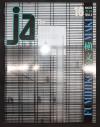 |
Yoshida, Yoshia (Ed.) Fumihiko Maki. (Special edition) The Japan Architect . Tokyo, 1994. 4°. 303, 24 p with many pictures in color. Illustr. OKart. (JA quarterly 16, Winter 1994-4).
Sehr gutes Exemplar. Schlagwörter: 20th Century, Architects, Architecture, Japan |
32,-- |  |
|
Einträge 1–36 von 36
Zurück · Vor
|
|||
| Seite: 1 |

